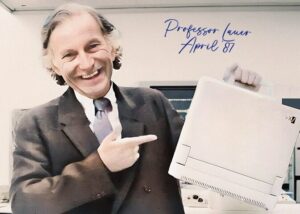Johannes von Laue
Known to most as Professor John Lauer, Johannes von Laue was a German mathematician and theoretical physicist who developed DEXscript for use on the CODEX (Compiler for Outer-world Dimensional Exploration) system.

Born October 1905 in Germany as Johannes Heinrich Otto von Laue, he was raised into hereditary nobility until the sudden dissolution of the German Empire in 1918 when he was 13 years old. He was quickly sent off to boarding school and attended the newly founded Schule Schloss Salem (Anglicization: School of Salem Castle) where he developed his interest in science and math.
In 1928, while studying for his doctorate degree at the University of Munich, Johannes was experimenting and analyzing the mass of electromagnetic field energy using a solution, of his own, to the Einstein field equations. During his analysis, he stumbled upon the theoretical existence of one-dimensional “tunnels” in spacetime. In his solution, he found that an electron at rest contains a finite mass that appears to have nothing to do with the energy of the associated field. He observed that inside these tunnels, “no space exists, and their boundaries are, analogous to infinite distance, inaccessible; they do not belong to the field”.
Perplexed by this discovery, he began to investigate further, though his research was soon interrupted when the Nazi’s gained power in 1933. Fearful for his Jewish wife, they fled to the United States where he took a job at the newly founded Institute for Advanced Study at Princeton University. It was typical during this time for immigrants to change names to better assimilate, so he then became known as Professor John Lauer.
In his private time, with the use of university equipment, he began to continue his research and theorized that these tunnels could actually be traversed. His colleagues did not agree, as the energy required would be something akin to a blackhole and require an enormous amount of exotic matter and negative energy density to work. This did not discourage him though. In his calculations he found that theoretically, microscopic traversable wormholes could be possible and not require any exotic matter, instead requiring only electrically charged matter with small enough mass that it cannot collapse. With this information, he began to design a device that would make his theory a reality.
In developing his designs and mathematically proving his equations, he found that there was one large problem. The technology to operate at a microscopic level needed for his device to function, was not possible with the current level of technology. It wasn’t until 1971 when the microprocessor was first invented, that the technology had finally caught up with his idea.